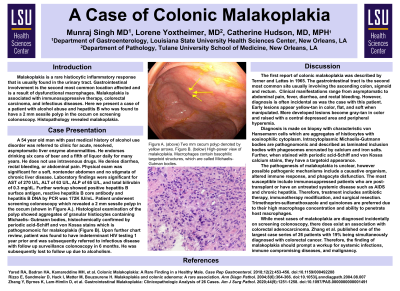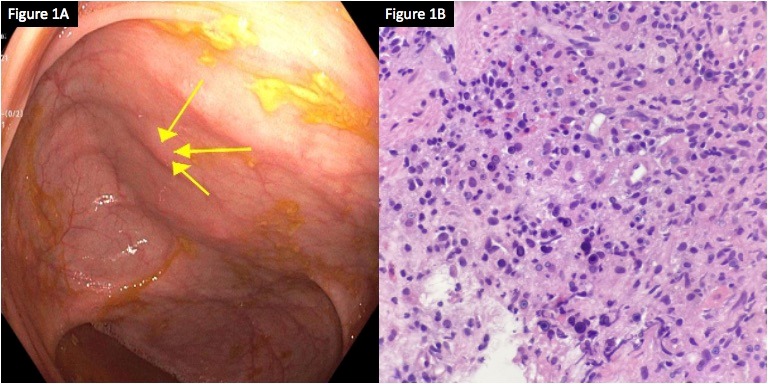Back


Poster Session B - Monday Morning
Category: Colon
B0154 - A Case of Colonic Malakoplakia
Monday, October 24, 2022
10:00 AM – 12:00 PM ET
Location: Crown Ballroom

Has Audio

Munraj Singh, MD
Louisiana State University Health Sciences Center
New Orleans, LA
Presenting Author(s)
Munraj Singh, MD1, Lorene Yoxtheimer, MD2, Catherine Hudson, MD, MPH1
1Louisiana State University Health Sciences Center, New Orleans, LA; 2Tulane School of Medicine, New Orleans, LA
Introduction: Malakoplakia is a rare histiocytic inflammatory response that is usually found in the urinary tract. Gastrointestinal involvement is considered the second most common location affected and is a result of dysfunctional macrophages. Histopathology is characterized by granular histiocytes with Micahelis-Gutmann bodies. Although usually an incidental finding, Malakoplakia is associated with immunosuppressive therapy, colorectal carcinoma and infectious diseases.
Case Description/Methods: A 54-year-old man with a pmhx of alcohol use disorder was referred to clinic for acute, asymptomatic liver enzyme abnormalities. Laboratory findings were significant for AST of 270 U/L, ALT of 63 U/L, ALP of 65 U/L, and total bilirubin of 0.3 mg/dL. Further workup showed positive hepatitis B surface antigen, reactive hepatitis B core antibody and hepatitis B DNA by PCR was 172K IU/mL. Patient underwent screening colonoscopy which revealed a 2 mm sessile polyp in the cecum (Figure 1A). Histological examination of the polyp showed von-Hansemann cells containing Michaelis-Gutmann bodies, which is diagnostic for malakoplakia (Figure 1B).
Discussion: The first report of colonic malakoplakia was described by Terner and Lattes in 1965 and usually involves the ascending colon, sigmoid colon and rectum. Clinical manifestations of colonic involvement range from asymptomatic to abdominal pain, fever, diarrhea and rectal bleeding. The lesion is characterized by von-Hansemann cells which are aggregates of histiocytes with eosinophilic cytoplasm and intracytoplasmic Michaelis-Gutmann bodies. Pathogenic mechanisms include a causative organism, altered immune response and phagocyte disfunction. Escherichia coli is the most common isolated pathogen found in 90% of patients with malakoplakia. These chronic bacterial infections are due to suspected abnormal macrophage function resulting in the inability to break down bacteria. The most susceptible include immunosuppressed patients who are post-transplant or have an untreated systemic disease such as chronic hepatitis. Antibiotic therapy, immunotherapy modification and surgical resection are the mainstay of management. While most cases of malakoplakia are diagnosed as incidental findings on screening colonoscopy, there does exist an associate with colorectal adenocarcinoma. Given the potential for significant morbidity if left untreated, malakoplakia diagnosed on incidental screening should prompt a work up for systemic infections, immune compromising diseases and malignancy.

Disclosures:
Munraj Singh, MD1, Lorene Yoxtheimer, MD2, Catherine Hudson, MD, MPH1. B0154 - A Case of Colonic Malakoplakia, ACG 2022 Annual Scientific Meeting Abstracts. Charlotte, NC: American College of Gastroenterology.
1Louisiana State University Health Sciences Center, New Orleans, LA; 2Tulane School of Medicine, New Orleans, LA
Introduction: Malakoplakia is a rare histiocytic inflammatory response that is usually found in the urinary tract. Gastrointestinal involvement is considered the second most common location affected and is a result of dysfunctional macrophages. Histopathology is characterized by granular histiocytes with Micahelis-Gutmann bodies. Although usually an incidental finding, Malakoplakia is associated with immunosuppressive therapy, colorectal carcinoma and infectious diseases.
Case Description/Methods: A 54-year-old man with a pmhx of alcohol use disorder was referred to clinic for acute, asymptomatic liver enzyme abnormalities. Laboratory findings were significant for AST of 270 U/L, ALT of 63 U/L, ALP of 65 U/L, and total bilirubin of 0.3 mg/dL. Further workup showed positive hepatitis B surface antigen, reactive hepatitis B core antibody and hepatitis B DNA by PCR was 172K IU/mL. Patient underwent screening colonoscopy which revealed a 2 mm sessile polyp in the cecum (Figure 1A). Histological examination of the polyp showed von-Hansemann cells containing Michaelis-Gutmann bodies, which is diagnostic for malakoplakia (Figure 1B).
Discussion: The first report of colonic malakoplakia was described by Terner and Lattes in 1965 and usually involves the ascending colon, sigmoid colon and rectum. Clinical manifestations of colonic involvement range from asymptomatic to abdominal pain, fever, diarrhea and rectal bleeding. The lesion is characterized by von-Hansemann cells which are aggregates of histiocytes with eosinophilic cytoplasm and intracytoplasmic Michaelis-Gutmann bodies. Pathogenic mechanisms include a causative organism, altered immune response and phagocyte disfunction. Escherichia coli is the most common isolated pathogen found in 90% of patients with malakoplakia. These chronic bacterial infections are due to suspected abnormal macrophage function resulting in the inability to break down bacteria. The most susceptible include immunosuppressed patients who are post-transplant or have an untreated systemic disease such as chronic hepatitis. Antibiotic therapy, immunotherapy modification and surgical resection are the mainstay of management. While most cases of malakoplakia are diagnosed as incidental findings on screening colonoscopy, there does exist an associate with colorectal adenocarcinoma. Given the potential for significant morbidity if left untreated, malakoplakia diagnosed on incidental screening should prompt a work up for systemic infections, immune compromising diseases and malignancy.

Figure: Figure 1A: Two mm cecum polyp denoted by yellow arrows.
Figure 1B: High-power view of Malakoplakia (60x). Macrophages containing basophilic targetoid structures, known as Michaelis-Gutmann bodies
Figure 1B: High-power view of Malakoplakia (60x). Macrophages containing basophilic targetoid structures, known as Michaelis-Gutmann bodies
Disclosures:
Munraj Singh indicated no relevant financial relationships.
Lorene Yoxtheimer indicated no relevant financial relationships.
Catherine Hudson indicated no relevant financial relationships.
Munraj Singh, MD1, Lorene Yoxtheimer, MD2, Catherine Hudson, MD, MPH1. B0154 - A Case of Colonic Malakoplakia, ACG 2022 Annual Scientific Meeting Abstracts. Charlotte, NC: American College of Gastroenterology.
